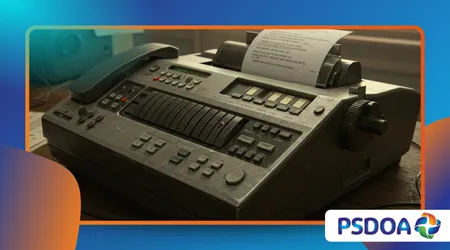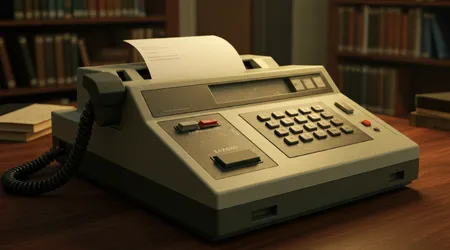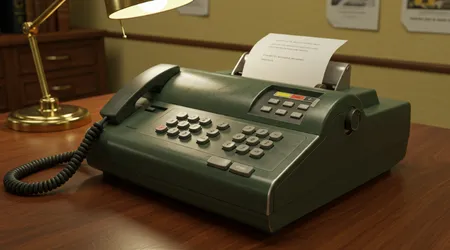The Fax Machine That Preceded the Telephone by 30 Years

Fax machine technology, often dismissed as a relic, holds a surprising secret: it predates the telephone by three decades.
Anúncios
Invented in 1843 by Alexander Bain, this groundbreaking device transmitted images over wires before voices could travel.
While we marvel at instant messaging today, the fax machine laid the groundwork for modern communication, a forgotten pioneer that deserves rediscovery. Its story is not just about wires and paper but about human ingenuity pushing boundaries.
Why don’t we celebrate this unsung hero of connectivity? Let’s dive into its origins, impact, and enduring lessons.
This journey through history reveals how a mechanical marvel shaped our world. From Bain’s crude prototype to its role in global business, the fax machine offers a lens into innovation’s unpredictable path.
Anúncios
We’ll explore its technical evolution, societal influence, and why it still lingers in 2025. Along the way, we’ll uncover real examples, a key statistic, and an analogy to spark curiosity. By the end, you’ll see why this invention matters more than you think.
The Dawn of the Fax Machine: A Spark of Genius
In 1843, Alexander Bain, a Scottish inventor, patented a device that could send images over telegraph lines.
His fax machine was a clunky, mechanical contraption, syncing two pendulums to transmit patterns. Unlike today’s sleek tech, it was a marvel of gears and wires.
Bain’s creation came before Bell’s telephone in 1876, a fact that stuns tech historians. This early fax machine proved visuals could travel faster than voices.
Bain’s invention wasn’t born in a vacuum. The 19th century buzzed with telegraphy experiments, and he saw a gap transmitting more than Morse code.
++ Pneumatic Tubes: How Cities Almost Ran on Air Power
His device used a stylus to etch images onto metal, a precursor to modern scanning. Imagine a painter’s brush, but mechanical, sending sketches across cities. This wasn’t just tech; it was a bold leap in human expression.
The significance of Bain’s work lies in its audacity. While others focused on words, he prioritized images, betting on visual communication’s power.
His fax machine faced skepticism too complex, too niche but it set a precedent. Early adopters, like newspapers, saw its potential for sharing illustrations. This spark of creativity laid the foundation for today’s digital imagery.

Technical Evolution: From Gears to Global Networks
Bain’s fax machine was primitive, relying on synchronized pendulums and electrochemical paper. By the 1860s, Giovanni Caselli’s pantelegraph improved reliability, transmitting handwriting commercially. These early systems were slow, requiring hours for a single page.
Yet, they were revolutionary, bridging distances with visuals. Imagine sending a map across continents in 1865!
The 20th century brought refinements. In 1924, AT&T developed the telephotography system, a precursor to modern faxing, used by newspapers for wirephotos.
By the 1980s, digital fax machines became office staples, with Group 3 standards enabling faster transmission.
Also read: The Ice Houses of Ancient Persia: Natural Refrigeration Without Electricity
A 1980s office worker could send a contract in minutes, a feat unimaginable a century earlier. This evolution mirrored the internet’s rise, connecting global businesses.
Today, in 2025, faxing persists in niche sectors like healthcare and law, where security matters. Statista reports that 43% of U.S. medical offices still use fax for patient records, valuing its reliability over email.
The fax machine’s journey from gears to digital signals shows technology’s relentless march. It’s not just history it’s a blueprint for innovation’s persistence.
Digital faxing, like eFax, integrates with cloud systems, proving adaptability. A lawyer in New York can fax a signed document to Tokyo instantly.
This seamless blend of old and new highlights fax’s resilience. It’s not flashy like AI, but it’s a quiet workhorse, still relevant in secure communication.
Societal Impact: Shaping Business and Culture
The fax machine transformed how businesses operated. In the 1980s, it became a symbol of global commerce, shrinking distances for contracts and designs.
Japanese firms, like Canon, led fax innovation, making it a cultural touchstone in Asia. A Tokyo architect could share blueprints with London overnight, fueling international collaboration.
Culturally, fax machines influenced art and media. In the 1960s, artists like Robert Rauschenberg used fax art, sending abstract images across galleries.
Read more: Self-Cleaning Clothes: A Forgotten Innovation That Still Impresses
This wasn’t just tech it was creativity unbound, like a digital canvas crossing borders. Fax also empowered newsrooms, transmitting photos faster than mail. It shaped a world hungry for instant visuals.
Yet, fax’s rise wasn’t flawless. It created dependence on paper, clogging offices with stacks of transmissions. In 2025, environmental concerns push digital alternatives, yet fax lingers where trust is paramount.
Its cultural legacy endures in secure sectors, a testament to its reliability. The fax machine didn’t just send documents it redefined global connectivity.
Consider a 1990s fashion designer faxing sketches to a Paris atelier. Speed and accuracy gave small businesses a global edge.
Fax’s role in democratizing communication is undeniable. It wasn’t perfect, but it built bridges where none existed, a quiet revolution in plain sight.
Why Fax Persists in 2025
Despite smartphones and email, the fax machine endures in 2025, especially in healthcare and legal fields. Why? Security and legal acceptance.
Faxed documents are harder to forge, and courts recognize them as binding. A doctor in Chicago faxes patient records to avoid email hacks, prioritizing trust over speed.
Fax’s persistence is also practical. Digital fax services, like HelloFax, integrate with email, blending old reliability with new convenience.
In 2025, 17% of small businesses still use fax for contracts, per a 2024 survey. It’s not nostalgia it’s utility. Fax machines offer a secure, traceable paper trail that emails often lack.
Analogies help here: fax is like a sturdy bridge in a digital city. While flashy new highways (like instant messaging) dominate, the bridge still carries critical traffic.
Fax’s resilience teaches us that not every innovation needs to be cutting-edge to matter. It’s a lesson in balancing tradition with progress.
Lessons from the Fax Machine for Today’s Innovators
The fax machine offers timeless lessons for 2025’s tech landscape. First, innovation doesn’t need to be perfect it needs to solve a problem.
Bain’s device was clunky but visionary, proving bold ideas can outpace skepticism. Today’s startups, like those in AI, should take note: start small, dream big.
Second, adaptability is key. Fax evolved from pendulums to digital signals, surviving centuries.
Modern innovators must pivot with user needs, like how fax integrated with cloud tech. A 2025 entrepreneur building VR tools could learn from fax’s ability to reinvent itself.
Finally, niche matters. Fax thrives in specific sectors, not everywhere. Innovators should target specific pain points, like secure document sharing, rather than chasing universal appeal.
The fax machine’s story isn’t just history it’s a playbook for creating lasting impact in a fast-changing world.
Consider a modern example: a startup develops a blockchain-based fax system for legal contracts, ensuring unalterable records.
This merges fax’s reliability with cutting-edge tech, showing how old ideas can inspire new solutions. The fax machine’s legacy is a reminder that innovation often builds on forgotten foundations.
The Fax Machine’s Cultural Echoes

Beyond technology, the fax machine shaped cultural moments. In the 1980s, fax art became a niche movement, with artists faxing distorted images to critique consumerism.
This wasn’t just tech it was rebellion, using a corporate tool for creative disruption. Galleries in New York displayed faxed art, blending tech with human expression.
Pop culture embraced fax too. In 1990s films like Jerry Maguire, fax machines were plot devices, symbolizing urgency and connection.
A sports agent faxing a mission statement to clients was cinematic drama, reflecting fax’s role in high-stakes communication. These echoes linger in how we view tech’s role in storytelling.
Even in 2025, fax’s cultural footprint persists. Digital artists experiment with “retro fax aesthetics,” mimicking grainy transmissions for nostalgia.
This shows fax’s influence isn’t just technical it’s a symbol of an era when instant communication felt magical, a spark that still inspires creative minds.
Table: Key Milestones in Fax Machine Development
| Year | Milestone | Description |
|---|---|---|
| 1843 | Alexander Bain’s Patent | First fax machine patented, using pendulums to transmit images over telegraph lines. |
| 1865 | Pantelegraph Introduced | Giovanni Caselli’s device enables commercial faxing of handwriting and images. |
| 1924 | AT&T Telephotography | Wirephoto system allows newspapers to transmit images quickly. |
| 1980s | Group 3 Fax Standard | Digital fax machines become office staples, enabling fast global communication. |
| 2025 | Digital Fax Integration | Cloud-based fax services like eFax thrive in secure sectors like healthcare. |
Conclusion: Rediscovering the Fax Machine’s Legacy
The fax machine, born before the telephone, is more than a dusty artifact. It’s a testament to human ingenuity, bridging eras with its stubborn resilience.
From Bain’s 1843 patent to 2025’s digital fax services, it shaped business, culture, and innovation.
Its story challenges us to look beyond shiny new tech and value ideas that endure. Like a river carving a canyon, the fax machine’s impact runs deep, shaping how we connect.
In 2025, as AI and VR dominate headlines, the fax machine reminds us that small ideas can spark big change. Its security and reliability still anchor critical industries, proving not all progress is flashy.
Let’s honor this forgotten pioneer by learning from its adaptability and vision. What other overlooked inventions might hold keys to our future?
Frequently Asked Questions
Why is the fax machine still used in 2025?
It’s valued for security and legal acceptance, especially in healthcare and law, where traceable, tamper-proof documents are critical.
How did the fax machine influence modern communication?
It pioneered instant visual transmission, paving the way for email, instant messaging, and digital document sharing.
Was the fax machine really invented before the telephone?
Yes, Alexander Bain patented the fax machine in 1843, 30 years before Bell’s telephone in 1876.
What industries rely on fax machines today?
Healthcare, legal, and small businesses use fax for secure, legally binding document transfers, with 43% of U.S. medical offices still relying on it.
